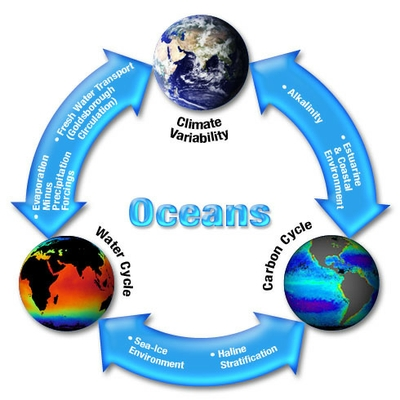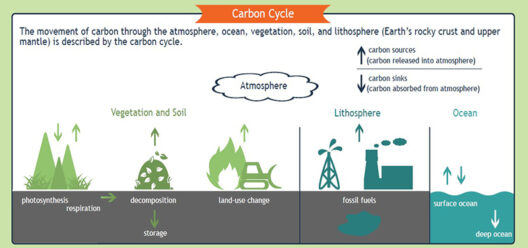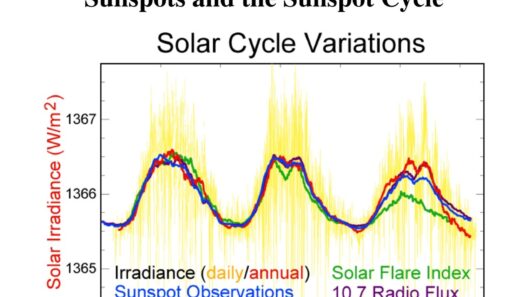The oceans are often perceived merely as vast bodies of water, but their role in shaping weather patterns and influencing climate change is monumental. They are not just a backdrop for maritime activities; they are dynamic systems that interact intricately with the atmosphere. Understanding this relationship is fundamental to grasping the multifaceted impacts of climate change.
First and foremost, oceans act as a colossal heat reservoir. They absorb approximately 90% of the excess heat generated by greenhouse gas emissions, a staggering statistic that underscores their importance in regulating global temperatures. This heat absorption is not uniform; rather, it varies by location, depth, and season. The process of heat distribution involves complex currents, which circulate warm water from the equator toward the poles and cold water from the poles back to the equator. This phenomenon not only mediates the Earth’s thermal balance but also directly affects weather systems.
One of the most significant implications of this heat reservoir function is the alteration of weather patterns. As ocean temperatures rise, the likelihood of extreme weather events increases. For instance, warmer sea surface temperatures contribute to more intense hurricanes and cyclones. These storms thrive on heat from the ocean, and as conditions become more favorable, the ferocity of these events escalates, causing socio-economic disruptions and ecological damage.
Furthermore, the oceans are pivotal in influencing precipitation patterns around the globe. The interaction between warm ocean waters and the atmosphere can increase evaporation rates, leading to a higher incidence of precipitation in some regions while fostering drought-like conditions in others. This dichotomy makes the oceans fundamental players in the water cycle, helping to redistribute moisture across continents. Changes in ocean temperature and circulation can thus drastically alter regional climates, often with dire consequences for agriculture, freshwater supply, and biodiversity.
In addition to influencing temperature and precipitation, oceans play a vital role in the carbon cycle. They act as a significant carbon sink, absorbing substantial amounts of carbon dioxide (CO2) from the atmosphere. This naturally occurring process helps mitigate the impact of greenhouse gases; however, it is not without repercussions. The dissolved CO2 reacts with seawater to form carbonic acid, leading to ocean acidification. This phenomenon poses a severe threat to marine ecosystems, particularly to calcifying organisms like coral reefs and shellfish. As these foundational species struggle to survive, the entire oceanic food web is jeopardized, which can cascade through ecosystems and ultimately affect human food sources.
The Oceanic Conveyor Belt, also known as thermohaline circulation, is another crucial element affecting both climate and weather. This complex system of ocean currents is driven by differences in water density, which is affected by temperature and salinity. The Conveyor Belt plays an integral role in regulating global climate by distributing heat and nutrients across the oceans and influencing atmospheric conditions. Disruptions to this system, often exacerbated by climate change, can lead to significant shifts in weather patterns, resulting in phenomena such as altered monsoon systems and drastic temperature changes.
Oceanic phenomena such as El Niño and La Niña exemplify the ocean’s profound influence on global climate. El Niño, characterized by the periodic warming of ocean waters in the central and eastern Pacific, has repercussions that ripple worldwide, leading to increased precipitation in some regions and droughts in others. Conversely, La Niña, which typically cools these waters, can exacerbate dry conditions in some areas and lead to flooding in others. Such oscillations underscore the ocean’s ability to initiate far-reaching climatic effects beyond its immediate vicinity.
As climate change accelerates, the implications for ocean health become increasingly dire. The rising sea levels, driven by the melting of polar ice caps and thermal expansion, threaten coastal communities and ecosystems. These changes can lead to the displacement of populations, loss of habitat, and degradation of marine biodiversity. Protecting oceanic environments is essential, not only for the sustainability of marine life but also for human resilience against climate change.
Moreover, there is growing recognition of the ocean’s role in climate regulation and the need for conservation strategies. Initiatives aimed at protecting marine ecosystems, such as establishing marine protected areas and promoting sustainable fishing practices, can enhance the oceans’ ability to withstand and adapt to climate changes. These efforts must be complemented by comprehensive policies that address the root causes of climate change, including reducing greenhouse gas emissions and promoting renewable energy sources.
Ultimately, understanding the integral relationship between oceans and climate change offers a nuanced perspective on environmental conservation. It emphasizes the interconnectedness of natural systems and the importance of ocean health in mitigating climate impacts. By fostering a curiosity about these complex interactions and advocating for proactive measures, society can better prepare for the challenges that lie ahead.
In conclusion, the oceans are undeniably crucial in shaping weather patterns and influencing climate dynamics. Their roles as heat reservoirs, carbon sinks, and vital components of the Earth’s water cycle underscore their importance in both current climate scenarios and future conditions. Engaging with oceanic conservation is not just an environmental necessity; it is an imperative for humanity’s collective survival in a changing world.






